There’s more to origami these days than merely folding paper pigeons, penguins, and bunny rabbits. Biologists now use origami to study folding in DNA and protein molecules. Physicists used it in the design of the space telescope; architects use it to model earthquake-resistant buildings. Mathematicians use it to explore geometry. Roboticists use it to build robots.
Educators have been touting the benefits of origami since the early 19th century, when Friedrich Frobel started the kindergarten movement in Germany. Paper-folding was an integral part of his original early-childhood curriculum, intended to teach kids essential principles of math and art – plus dexterity, creativity, and spatial skills.
And some of it is easy. Even I can make a pigeon.
Table of Contents
BOOKS: BIRDS, BUTTERFLIES, AND FOLDED POEMS
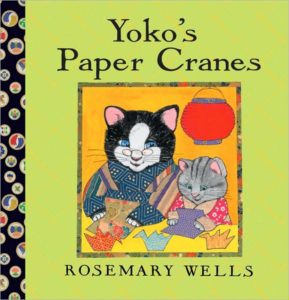
|
In Yoko’s Paper Cranes by Rosemary Wells (Hyperion, 2009), Yoko, who lives with her parents in the United States, misses Japan, where she remembers feeding the cranes in her grandparents’ garden. She was so unhappy when the cranes left on their seasonal migration that her grandmother taught her how to make paper cranes – to remind her that the cranes would always return. Now, from across the ocean, Yoko sends her grandmother a birthday gift of paper cranes as a token that soon she too will return for a visit to Japan. Illustrated with lovely collages. The characters are all cats (in Yoko’s case, a kitten) who wear gorgeously patterned kimonos. For ages 3-7. |
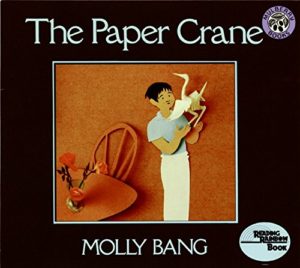
|
Molly Bangs’s The Paper Crane (Greenwillow Books, 1987) is the story of a restaurant owner and his little son who lose their business when a new highway is built. Nevertheless, they give a free meal to an old man who, in return for their kindness, makes an origami crane from a table napkin – which comes to life at the clap of their hands. People pour into the restaurant to see the magical crane and soon business is booming once more. Finally, the old man returns and – after the crane dances to his flute – he flies away on the crane’s back. For ages 4-8. |
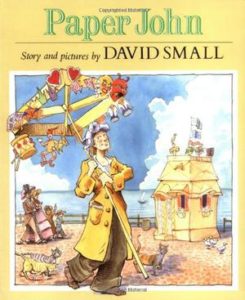
|
In David Small’s Paper John (Live Oak Media, 1998), John makes his living as a peddler, selling paper toys. He lives in a paper house by the sea (a wonderful illustration shows a row of colored pinwheels on the roof) and he folds paper boats for all the town’s children. When an angry imp blows the town out to sea, John, unfazed, folds his paper house into a ship and saves the day. For ages 4-8. |
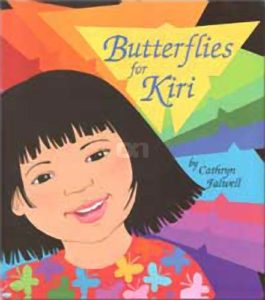
|
Cathryn Falwell’s Butterflies for Kiri (Lee & Low, 2008) is a good pick for frustrated paper-folding beginners. Kiri is thrilled to get an origami kit for her birthday – but it doesn’t live up to her expectations; the instructions are difficult, the paper tears, and she gives up in disappointment. Instead, she paints a picture, then returns to the kit to add some paper flowers to her watercolor – and finally succeeds in folding an origami butterfly. The encouraging message, of course, is “Try, try again.” For ages 4-8. |
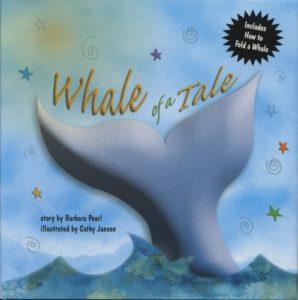
|
In Barbara Pearl’s picture book Whale of a Tale (Crane Books, 2005), a versatile square of paper turns itself into a kite, a whale, and a penguin. (Instructions are included so that kids can fold along with the story.) For ages 4-8. |
| Make your own whale! See the Whale Lesson Plan which has instructions for a simple origami whale with extension activities. | |
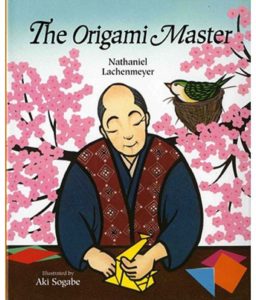
|
In Nathaniel Lachenmeyer’s picture book The Origami Master (Albert Whitman & Company, 2008), Shima the Origami Master lives alone high in the mountains, with only his paper animals to keep him company. A bird who lives in a nearby tree watches him work, and then – while Shima is asleep – flies in the window and makes animals of its own, far better than Shima’s creations. Shima captures the bird and locks it in a cage with some origami paper, hoping to discover its secrets. The captive bird refuses to make anything – and the next morning Shima finds that it has escaped from the cage, leaving behind an origami key. Shima, ashamed, then makes a beautiful origami nest that he leaves in the tree “for the friend he almost lost.” Included are instructions for folding an origami bird. For ages 4-9. |
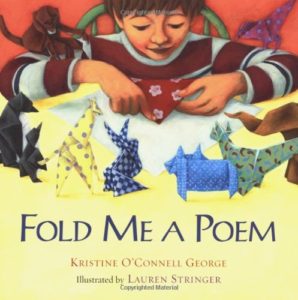
|
In Kristine O’Connell George’s Fold Me a Poem (Harcourt Children’s Books, 2005), a little boy spends a day folding origami animals, each of which is accompanied by a clever poem and a colorful acrylic illustration. (“All afternoon/the paper cows/have been eyeing/the green paper. Oh!/Grass.”) There are 32 poems in all. A great kick-off for making origami-and-poetry books of your own. For ages 5-9. |
ONE THOUSAND PAPER CRANES
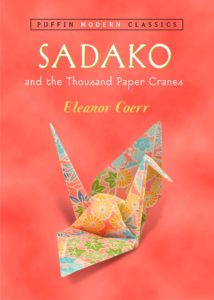
|
Eleanor Coerr’s Sadako and the Thousand Paper Cranes (Puffin, 2004) is the story of a young girl who contracted leukemia – “atom bomb disease” – after exposure to radiation in the wake of the World War II Hiroshima bombing. Having heard the legend that anyone who folds a thousand paper cranes will have good fortune, Sadako begins to make origami cranes. She dies before achieving her goal, but her classmates complete the project for her – and ever since children worldwide have folded paper cranes in her memory as a symbol of global peace. For ages 8-13. |
| Sadako and the Thousand Paper Cranes has a reading guide, discussion questions, and activities to accompany the book. | |
| Fold a Paper Crane has step-by-step instructions, nicely illustrated with photographs. | |
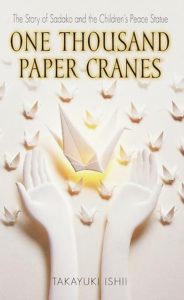
|
Ishii Takayuki’s One Thousand Cranes: The Story of Sadako and the Children’s Peace Statue (Laurel Leaf, 2001) is a 112-page history, illustrated with period photos, on the bombing of Hiroshima and its aftermath, the experiences of Sadako and her family, Sadako’s death from leukemia, and the establishment of the Hiroshima Peace Park with its Children’s Peace Statue. For ages 10 and up. |
